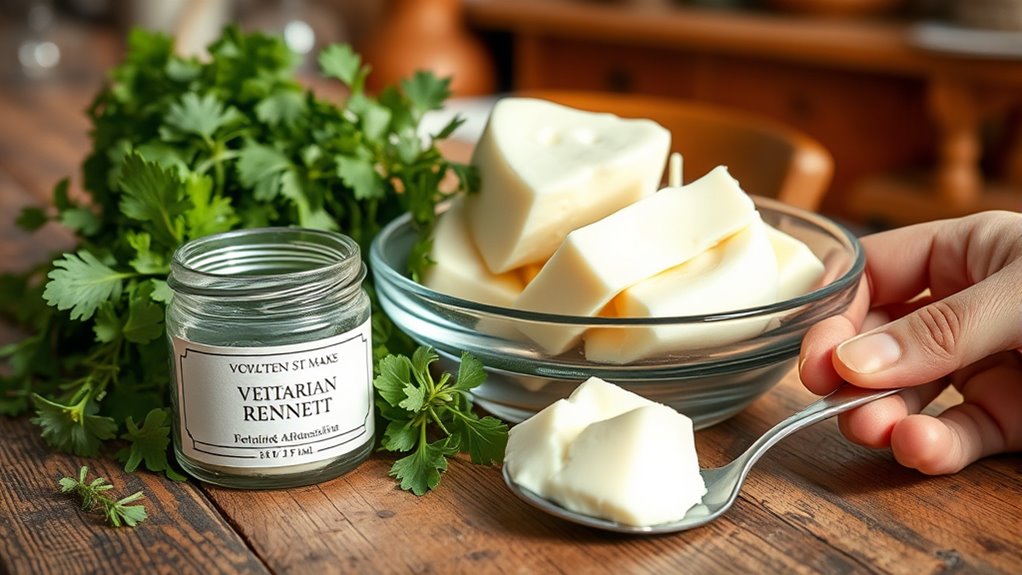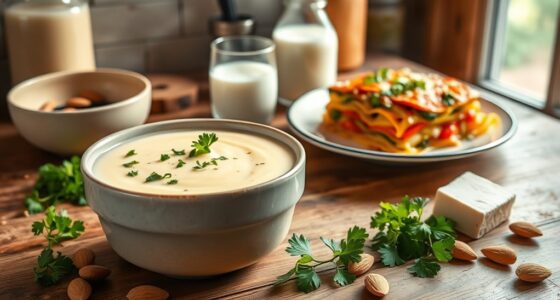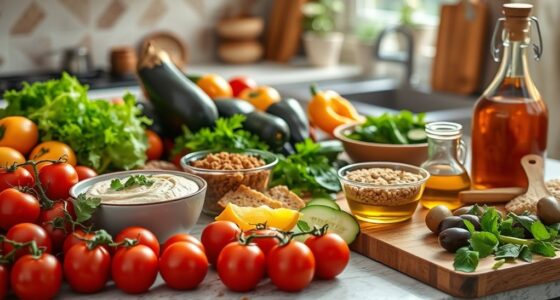Cheese fermentation relies on microbes like bacteria, yeasts, and molds that produce enzymes breaking down fats, proteins, and carbs, shaping flavors and textures. Traditionally, animal rennet with enzymes like chymosin was used to curdle milk, but now vegetarian options made through microbial fermentation are common. These microbial enzymes mimic animal rennet and support sustainable, ethical cheesemaking. To see how these processes work together to create your favorite cheeses, keep exploring the fascinating science behind cheese production.
Key Takeaways
- Microbial communities produce enzymes like proteases and lipases that catalyze milk component breakdown during cheese fermentation.
- Vegetarian rennet uses microbial or plant-derived enzymes to coagulate milk, mimicking animal rennet without animal sources.
- Microbial fermentation ensures consistent, safe enzyme production, supporting sustainable and ethical vegetarian cheese-making.
- Enzymes initiate curd formation by hydrolyzing casein, influencing cheese texture, flavor development, and maturation process.
- Advances in fermentation technology and enzyme engineering enhance cheese quality, flavor complexity, and support vegetarian and eco-friendly practices.
The Microbial World Behind Cheese Aging
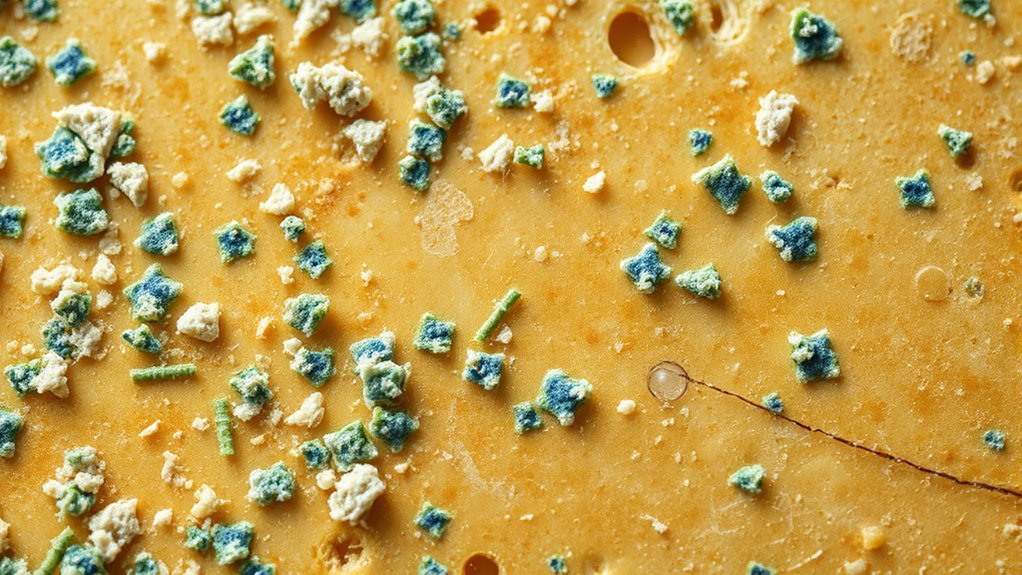
The microbial world plays a crucial role in cheese aging, as it drives the development of flavor, texture, and aroma. During cheese aging, diverse microbial communities, including bacteria, yeasts, and molds, interact with the cheese surface and interior. These microorganisms break down fats, proteins, and carbohydrates, producing compounds that shape the cheese’s character. Different microbes dominate at various stages, influencing the complexity of flavors and the formation of rind textures. Understanding these microbial communities helps producers control the aging process and achieve specific qualities. Recognizing the importance of vetted microbial strains ensures a consistent and controlled fermentation process. Without these active microbes, cheese aging wouldn’t be possible, making microbial communities fundamental to the craft. Microbial diversity is essential for developing the unique profiles of different cheeses, as it introduces a wide range of flavors and textures. Additionally, studying microbial interactions allows cheesemakers to optimize fermentation conditions for superior products.
Enzymes and Their Role in Milk Transformation
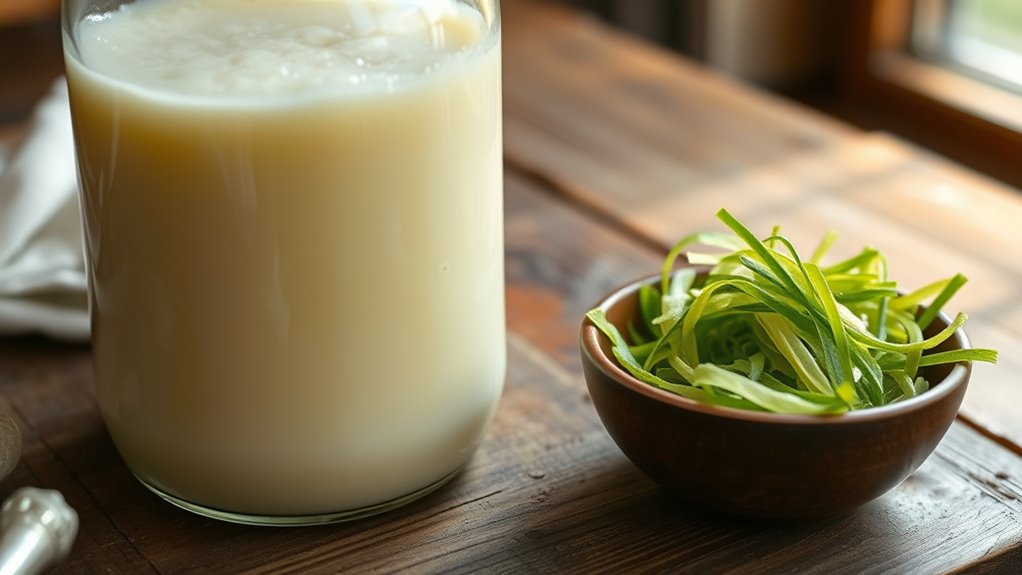
As microbes work behind the scenes during cheese aging, enzymes produced by these microorganisms start transforming milk components from the moment they’re introduced. Enzyme specificity determines which milk proteins, fats, or carbohydrates they target, shaping the cheese’s texture and flavor. For example, proteases break down casein proteins, leading to curd formation, while lipases influence fat breakdown. Enzyme stability is essential; stable enzymes remain active throughout fermentation, ensuring consistent results. If enzymes denature too quickly, the process becomes unreliable, affecting cheese quality. Understanding enzyme behavior helps cheesemakers control fermentation precisely. By selecting microorganisms with the right enzyme specificity and stability, you can influence the cheese’s characteristics, ensuring the final product meets desired taste and texture standards. Enzyme stability is a key factor in maintaining consistent cheese quality throughout fermentation, especially when using vegetarian rennet which relies on microbial enzymes rather than animal-derived enzymes. Additionally, microbial enzymes contribute to the development of distinctive flavors unique to vegetarian cheeses.
The Evolution of Rennet and Its Alternatives
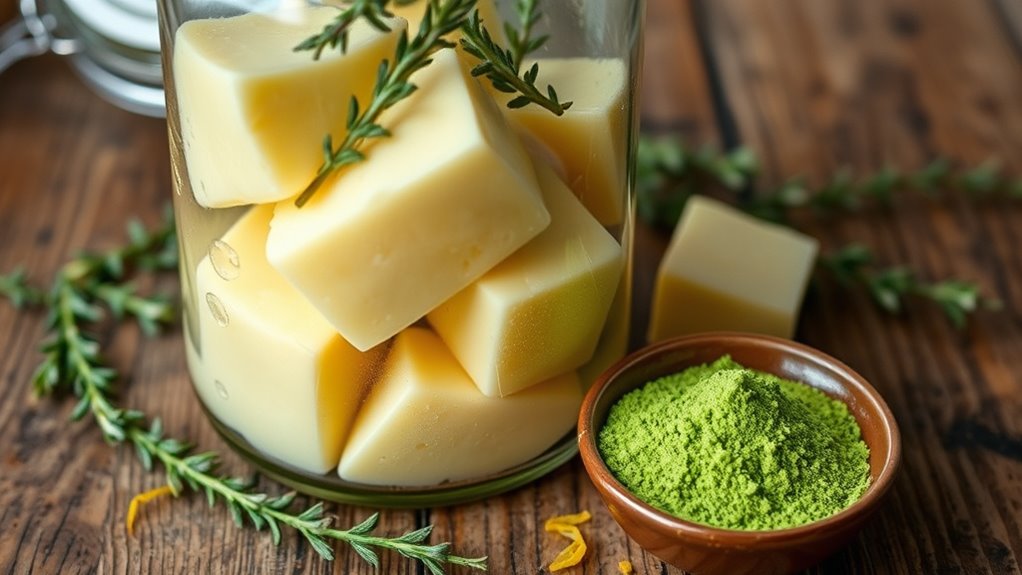
You’ve likely heard of traditional animal rennet, which has been used for centuries in cheese making. Recently, plant-based rennet innovations have gained popularity as ethical and sustainable alternatives. Exploring how these options have evolved can help you understand their impact on cheese production today.
Traditional Animal Rennet Use
Traditional animal rennet has long been the cornerstone of cheese-making, relying on enzymes extracted from the stomachs of young calves to curdle milk. These milk enzymes, primarily chymosin, work with cheese culture to transform liquid into solid curds. When you use animal rennet, you’re selecting a method rooted in centuries of tradition. Imagine:
- A butcher carving out the stomach of a calf, enzymes ready for extraction.
- The rennet being added to warm milk, causing it to coagulate swiftly.
- The curds forming, ready for pressing into cheese.
This process highlights how milk enzymes interact with cheese culture, creating the curds that define cheese. Though effective, this traditional method has prompted the search for vegetarian and plant-based alternatives. Understanding the role of enzymes can help in exploring these modern options, especially as research into creative and innovative methods advances. Additionally, awareness of resources and tools available for cheese fermentation can aid producers in selecting suitable substitutes. Recognizing sustainable practices in cheese production is also becoming increasingly important for environmentally conscious cheesemakers.
Plant-Based Rennet Innovations
In recent years, innovators have developed plant-based rennet as a sustainable and ethical alternative to animal-derived enzymes. These plant-based options support cheese aging without compromising flavor or texture. They work by mimicking the microbial interactions that traditionally occur during fermentation, helping curds coagulate effectively. This process is crucial because, as cheese ages, the microbial communities interact with the curd, influencing flavor development and texture, and plant-based rennet facilitates this process naturally. Researchers are exploring sources like thistles, nettles, and microbial enzymes from fungi and bacteria to improve consistency and performance. Additionally, the environmental impact of traditional rennet production has raised concerns, prompting a shift toward plant-based solutions. This evolution makes cheesemaking more accessible for vegetarians and those seeking eco-friendly options, all while maintaining the essential microbial interactions that define cheese fermentation. Nutritional benefits of using plant-based rennet include reduced environmental impact and support for animal welfare, aligning with sustainable food practices. Moreover, the development of plant-based rennet supports sustainable food practices by reducing reliance on animal farming and promoting eco-friendly methods. These innovations foster a more sustainable future for cheese production.
How Vegetarian Rennet Is Produced and Functioned
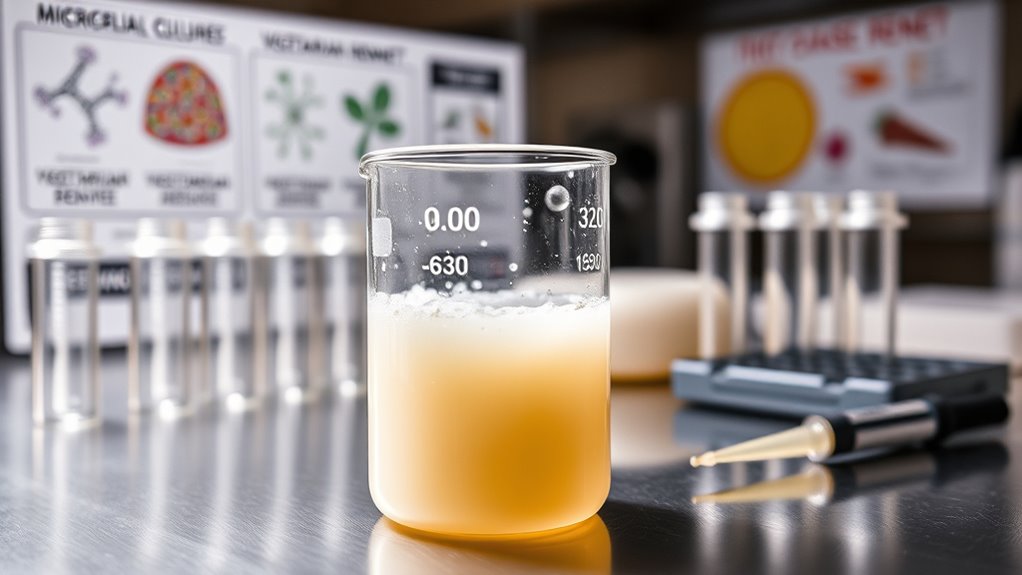
Vegetarian rennet is produced using microbial fermentation, where specific microbes generate the necessary enzymes. These enzymes then work to coagulate milk through enzymatic milk coagulation, creating cheese without animal-derived rennet. Understanding how these processes operate helps you appreciate vegetarian cheese options and their production methods. Additionally, the fermentation process ensures that the enzymes are safe and effective for cheese making. The types of microbes used in fermentation are carefully selected to produce enzymes that mimic those found in traditional animal rennet, ensuring consistent and high-quality cheese production. The compatibility of microbial enzymes with various types of milk further enhances the versatility of vegetarian rennet. This approach aligns with ethical hacking principles by employing safe and controlled processes to achieve desired results.
Microbial Rennet Production
Microbial rennet is produced through a fermentation process that involves specially cultivated microorganisms, such as fungi or bacteria. You might imagine a controlled laboratory where genetic engineering tailors these microbes for ideal enzyme production. The process leverages microbial diversity to find strains with high protease activity, essential for cheese coagulation. To produce rennet, scientists:
- Select diverse microorganisms based on their natural ability to produce specific enzymes.
- Use genetic engineering to enhance enzyme yield and stability.
- Cultivate these microbes in large fermentation tanks under precise conditions for maximum output.
This approach guarantees vegetarian rennet is consistent, efficient, and free from animal sources. By harnessing microbial diversity and genetic engineering, producers create reliable, sustainable rennet alternatives for cheese-making enthusiasts like you.
Enzymatic Milk Coagulation
Enzymatic milk coagulation is the process by which specific enzymes cause milk proteins to curdle, forming the basis of cheese production. This process involves activating particular enzymatic pathways that target milk enzymes like caseinases, which break down casein proteins. Vegetarian rennet typically contains plant-derived or microbial enzymes that mimic animal rennet’s function. When added to milk, these enzymes catalyze the hydrolysis of casein molecules, leading to curd formation. The efficiency of coagulation depends on the enzyme’s specificity and activity, which are carefully controlled during production. Understanding enzymatic pathways helps optimize cheese texture and flavor. Additionally, the sustainability of vegetarian rennet makes it an increasingly popular choice among eco-conscious producers. Enzymatic activity plays a critical role in determining the quality and consistency of the final cheese product. By harnessing these milk enzymes, vegetarian rennet provides a sustainable and animal-free alternative for cheese makers worldwide.
The Impact of Fermentation on Cheese Flavor and Texture
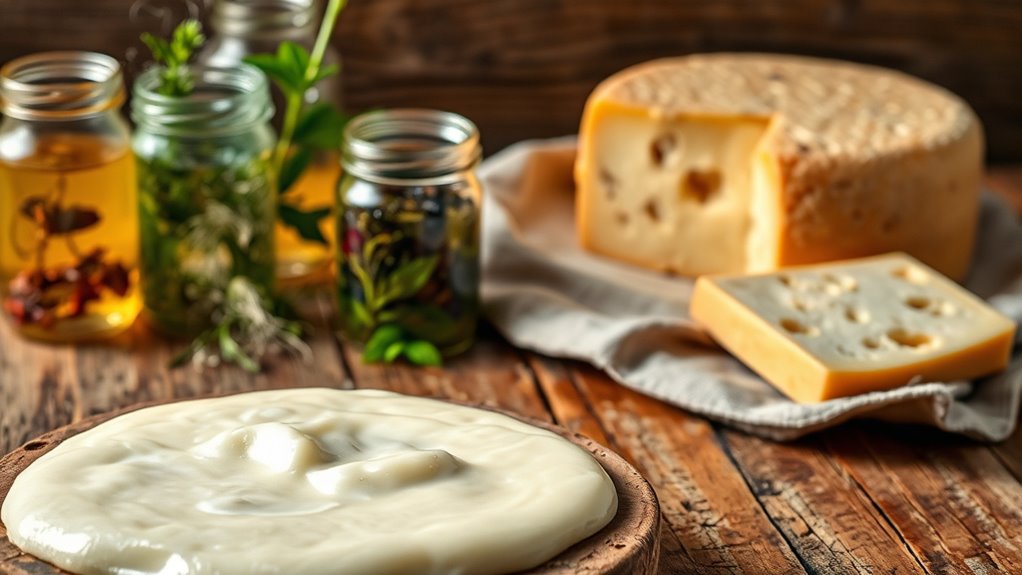
Fermentation plays a crucial role in shaping the flavor and texture of cheese, transforming simple milk into a complex, nuanced product. During cheese ripening, fermentation drives flavor development by breaking down fats, proteins, and sugars. This process results in a variety of textures and tastes that evolve over time. Imagine:
- A crumbly, sharp cheddar developing a rich, nutty aroma.
- A smooth, creamy Brie with a delicate, buttery taste.
- A firm, aged Parmesan with a savory, umami punch.
These changes are driven by microbial activity, which influences the cheese’s structure and sensory qualities. Fermentation not only enhances flavor but also refines texture, creating the unique character of each cheese. Your palate experiences this transformation as the cheese matures, revealing layers of depth and complexity.
Innovations Shaping the Future of Cheese-making
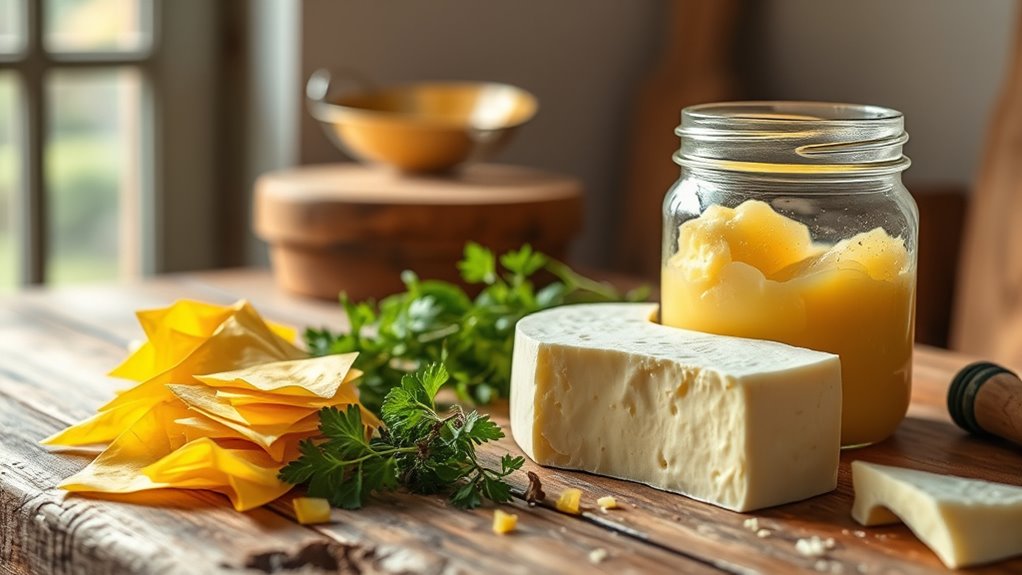
Advancements in technology and sustainability are driving exciting innovations in cheese-making. Modern aging techniques now allow you to control environmental factors precisely, leading to more consistent flavor development. Innovative approaches, like accelerated aging or using specific aging chambers, help develop complex flavors faster without sacrificing quality. Researchers are also exploring new ways to enhance flavor profiles through natural additives and optimized fermentation processes. These innovations enable you to produce unique cheeses tailored to consumer preferences while reducing environmental impact. Vegetarian rennet alternatives integrate seamlessly into these advancements, ensuring ethical and sustainable production. As these techniques evolve, you’ll have more control over cheese characteristics, resulting in a broader range of flavors and textures that meet both tradition and innovation.
Frequently Asked Questions
How Do Specific Microbes Influence Cheese Aging Outcomes?
You might wonder how microbes affect cheese aging, and it all comes down to microbial diversity shaping fermentation processes. Different microbes contribute unique enzymes that influence flavor, texture, and aroma development over time. As these microbes interact, they create complex biochemical changes. By controlling microbial diversity, you can steer fermentation processes to achieve desired cheese characteristics, making aging outcomes more predictable and enhancing the final product’s quality.
What Are the Environmental Impacts of Traditional vs. Vegetarian Rennet Production?
You might wonder about the environmental footprint of traditional versus vegetarian rennet production. Traditional rennet often relies on animal sources, which can impact resource sustainability due to farming and processing requirements. Vegetarian rennet, usually produced through microbial or plant-based methods, tends to have a lower environmental footprint, conserving resources and reducing ethical concerns. Choosing vegetarian options helps you support more sustainable practices, benefiting the environment and promoting resource conservation.
Can Fermentation Techniques Be Customized for Unique Cheese Flavors?
Fancy flavor forging? Yes, you can customize fermentation techniques to create unique cheese flavors. By fine-tuning microbial customization, you control flavor profiling, resulting in distinct tastes and textures. You manipulate specific bacteria and molds, tailoring fermentation environments to evoke desired flavor profiles. This precision allows you to craft cheeses that stand out, satisfying both palate and personality. So, with creative microbial management, you turn traditional cheese-making into an art of aromatic innovation.
Are There Health Benefits Associated With Vegetarian Rennet Cheeses?
You might wonder if vegetarian rennet cheeses offer health benefits. These cheeses often contain fewer animal fats and additives, providing nutritional advantages like lower cholesterol and increased plant-based nutrients. Additionally, vegetarian rennet can make cheese suitable for those with dietary restrictions or ethical preferences. While they may not drastically differ nutritionally from traditional cheeses, choosing vegetarian rennet options can support a healthier, more ethical diet with potential added health benefits.
How Do New Biotechnologies Affect Cheese Safety and Quality?
You’re on the right track by asking how new biotechnologies impact cheese safety and quality. These innovations, like genetic modification and microbial engineering, act as double-edged swords—improving safety and consistency but raising concerns. They help control pathogens and enhance flavor, yet necessitate rigorous testing. Embracing these tools can boost cheese quality, but you must stay vigilant to assure consumer trust and safety aren’t compromised.
Conclusion
Think of cheese-making as a delicate dance between microbes, enzymes, and tradition, each step guided by nature’s unseen forces. As you explore vegetarian rennet and fermentation, you become part of this timeless performance, shaping flavors and textures with every choice. Embrace the evolving science behind cheese, knowing you’re supporting innovation and sustainability. Like a master conductor, you hold the power to create harmony in every bite, turning simple ingredients into edible art.
Aurelia is the Editor-in-Chief of The Graceful Kitchen, a vegan lifestyle blog that focuses on delicious, nutritious, and ethical eating. A lifelong vegan, Aurelia is passionate about sharing her love of plant-based cuisine with others. She is a regular contributor to several online and print publications, and has been interviewed by major news outlets about the benefits of a vegan diet. In her free time, Aurelia enjoys cooking, hiking, and spending time with her cats.
